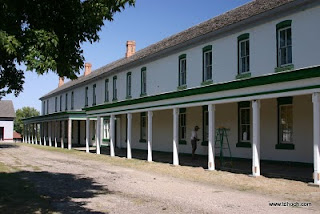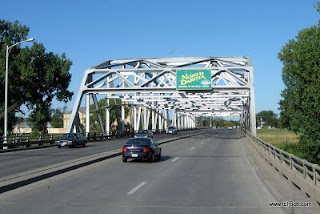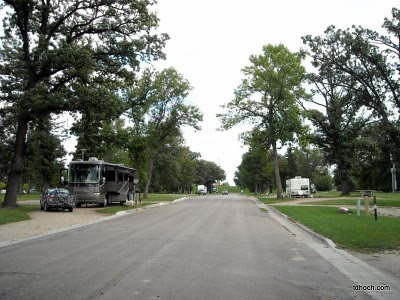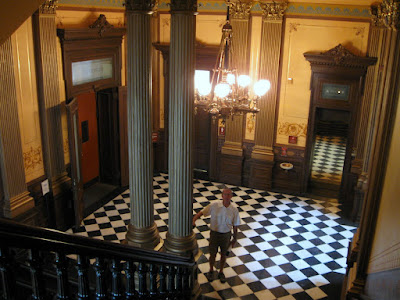It wasn't supposed to happen this way; it certainly wasn't part of the plan. But there I was, laying on the ground, writhing in intense pain... wondering what happened. Am I loosing consciousness? Why can't I see clearly?... all I see are stars... and I can't seem to catch my breath. What's going on? Ahhh!
Maybe I should start at the beginning.
Here at Camp Soldner we're close to nature. Deer are regular visiters. Once in a while moose wander through. Beavers regularly plug up nearby rivers and streams. Our neighbor Bill reports that he found a black bear in his open garage one morning. Many have seen wolves, which were re-introduced to the UP some years ago. Then there are the birds... mostly waterfowl. Ducks, loons, cormorants, and, of course, the ubiquitous Canada goose.
I've had a long-standing grudge against the Canada goose (see previous
blog entry on this filthy fowl) which, years ago, would migrate through the upper Midwest and impress us for a few weeks each Spring and Fall with their incredible numbers. But as the years wore on and the planet warmed (or "cooled" if you fall on the other side of the "global warming" controversy) the geese just stopped. They didn't stop coming... oh no, that would have been fine with me... they stopped
going. They decided things were pretty darned good in these newly warmed (cooled) environs, and they just stopped migrating altogether. They just stayed... 12 months a year. They moved in like an indigent brother-in-law, hung around, laid on the couch, watched TV, ate everything in sight, and made a mess wherever they went. (calm down Thom!)
Dennis and Laura, the owners of Camp Soldner, have had an ongoing battle with these geese too. For whatever reason, the local gang of geese like the lawn here at the Camp... especially in the morning, when the rising sun warms the succulent grass they love to eat and provides a cozy place to warm up on cold mornings. Every remedy known to a Yooper has been implemented. They've tried it all... scarecrows (took care of the crows, but the geese weren't fazed), monofilament fishing line strung along the shoreline on short poles (stopped the amphibious landings... but they just started flying in), even sacrifices to the waterfowl gods... nothing worked.
So, since we've been here, the first chore when getting up is to see if the gang has showed up, and if so, go out and shoo them away -- another seemingly ineffective solution. You just can't be here every minute of every day.
In my mind, I formulated a plan with the assumption that geese, having very limited intelligence, might be "scared straight". If they were scared to the edge of life and death (in their minds), they might decide the grass is more succulent on someone else's lawn. Hmmm. With the right execution, this just might work.
Well, the other day I woke to a bright sunny morning. I shuffled my stiff body out to the kitchen of the bus-house, semi-blinded by the sun boring in through the big 4 acre east-facing windshield. I looked over the lake, absorbed the sights of nature and another glorious day, and... that danged gang of geese over on the other side of the Camp. Alright, this is the moment... this is the opportunity. This is the perfect chance to implement the plan I put together. If I could sneak out of the bus-house, work my way through a mine-field of goose poop without being seen... to the back side of the sauna building, and then jump out -- only a few feet from the offensive fowl -- running and screaming like a mad-man right at them... well, why would they ever take the chance of having that experience again?
I slipped on my favorite Keen sandals, quietly opened the bus-house door, and worked by way over to the sauna. OK... so far... so good. I don't think they saw me. I peeked around the corner... there were at least 15 of 'em. This is gonna be good! Now's the time...
My just-moments-before sleeping body was called into action by my scheming brain... I shot around the corner of the sauna and right for the middle of the pack of poopers like a 22 year old line backer trying to prove he's got the stuff to make the "A" team. After the first two powerful strides things started to go awry. Sirens and alarms started going off in my head. (Ah, Houston, we have a problem!) A sudden sharp pain tore through the back of my upper left leg... followed by the same pain in my upper right leg. My upper body was going faster than my legs... and I couldn't control much of anything... what's wrong?... this ain't right!.. why am I seeing stars... I'm going down and going down hard... uncontrolled... knees and elbows and geese flying everywhere... it must have been ugly. I hit the ground and rolled and tumbled and yelled and eventually stopped... I hurt everywhere... but especially the back-sides of my upper legs. I was losing consciousness.... seeing stars... narrowing vision... but was able to roll around and try to find a position where the pain would ease. Nothing helped. I concentrated on breathing deeply... must keep from passing out... Dar didn't see any of this and she's sleeping in the bus-house on the other side of the sauna... if I died here she wouldn't find me until she woke up at 10am... and I'd be as hard and cold as a washed up carp.
I did hear our neighbor Bill, who was a couple hundred feet away on his moored pontoon boat and apparently saw the whole thing... wondering if I was OK... if I needed help. I waved and got out a pained "I'm OK... I'm OK"
After laying there for a few moments (If I actually passed out it could have been longer) I struggled over to a lawn swing... sat there for a few moments and remember still seeing mostly stars... very poor and unclear vision... struggling for air... a little nauseous too. This isn't getting any better. Must get to bus-house and to the nurse that resides within (AKA The Safety Director). It's my only chance.
I crawled, actually a combination of walking and crawling, over to the bus-house... leaned against the front end for support... worked my way around to the door... opened it and inquired as to whether the Nurse was available for a consultation. She came to the door, saw me, my lack of color, the pained expression on my face, my inability to maintain my balance, my eyes crossing and rolling back in their sockets...and she asked if I had a problem. OK, she might have asked "what did you do now?!"... I don't know... memories are choppy at this point.
She did help me into the bus-house and into a chair. She thought I might pass out again and wanted me on the couch... but I couldn't... not just then... not yet. It took another 10 minutes or so to come around, to get past the worst of it, but the pain was still with me. She said I'd probably pulled a hamstring. I said, I think I pulled both of 'em. Whoa!
Since that time, things have improved. I'm feeling better but walking pretty slow. I'm using my hiking stick as a makeshift cane to steady myself as it all slowly heals.
The geese? They've been back almost every day, probably hoping to see another spectacle like that one the other day. I'm sure they've been talking with their geese buddies all over the U.P... telling them all about the Incredible Galloping Geezer Show... how funny it is... how it's a "must see".
Danged Geese!
Enjoying the medically necessary massages on my backside...
Thom


















































